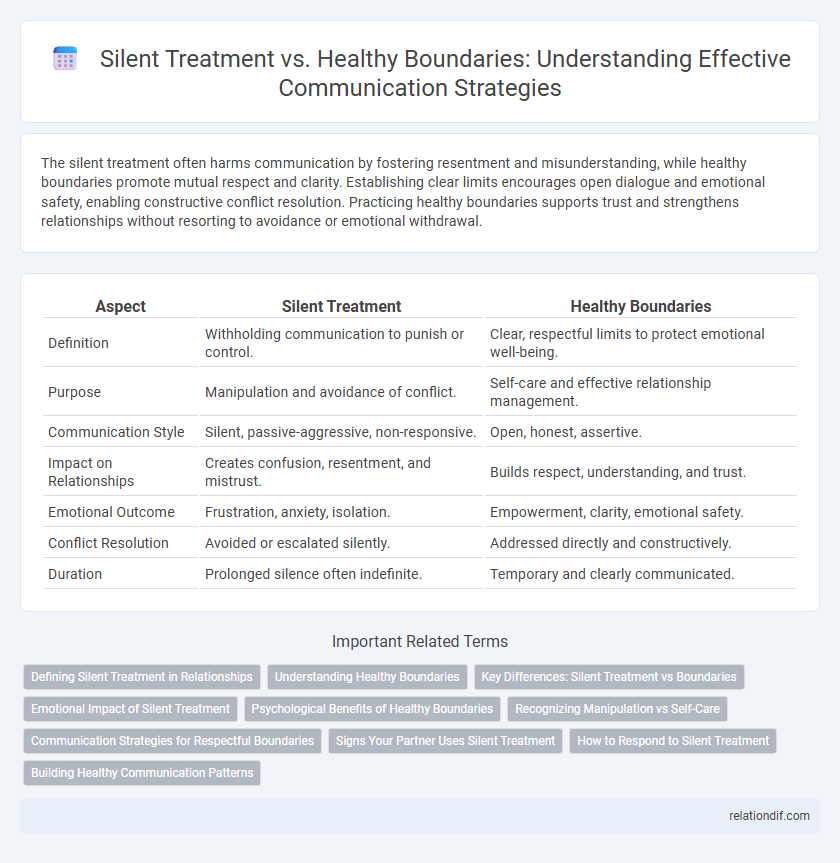The silent treatment often harms communication by fostering resentment and misunderstanding, while healthy boundaries promote mutual respect and clarity. Establishing clear limits encourages open dialogue and emotional safety, enabling constructive conflict resolution. Practicing healthy boundaries supports trust and strengthens relationships without resorting to avoidance or emotional withdrawal.
Table of Comparison
| Aspect | Silent Treatment | Healthy Boundaries |
|---|---|---|
| Definition | Withholding communication to punish or control. | Clear, respectful limits to protect emotional well-being. |
| Purpose | Manipulation and avoidance of conflict. | Self-care and effective relationship management. |
| Communication Style | Silent, passive-aggressive, non-responsive. | Open, honest, assertive. |
| Impact on Relationships | Creates confusion, resentment, and mistrust. | Builds respect, understanding, and trust. |
| Emotional Outcome | Frustration, anxiety, isolation. | Empowerment, clarity, emotional safety. |
| Conflict Resolution | Avoided or escalated silently. | Addressed directly and constructively. |
| Duration | Prolonged silence often indefinite. | Temporary and clearly communicated. |
Defining Silent Treatment in Relationships
Silent treatment in relationships refers to the intentional refusal to communicate or respond to a partner as a form of emotional punishment or control, often leading to feelings of isolation and confusion. Unlike healthy boundaries that promote respectful space and mutual understanding, silent treatment undermines trust and hampers resolution of conflicts. Recognizing silent treatment as emotional manipulation is crucial for fostering open communication and emotional well-being in relationships.
Understanding Healthy Boundaries
Understanding healthy boundaries is essential for effective communication and emotional well-being. Unlike the silent treatment, which often aims to punish or control, healthy boundaries involve clearly expressing personal limits and respecting others' feelings. Establishing these boundaries fosters mutual respect, reduces misunderstandings, and promotes open, honest dialogue in relationships.
Key Differences: Silent Treatment vs Boundaries
Silent treatment involves deliberately ignoring or refusing to communicate as a form of punishment or control, negatively impacting trust and emotional connection. Healthy boundaries establish clear, respectful limits on communication and behavior to protect individual well-being without causing harm or resentment. The key difference lies in intent: silent treatment seeks to manipulate or hurt, while boundaries aim to promote mutual respect and emotional safety.
Emotional Impact of Silent Treatment
Silent treatment often causes emotional distress by fostering feelings of rejection, confusion, and isolation, which can damage trust and intimacy in relationships. Healthy boundaries establish clear expectations for communication, promoting mutual respect and emotional safety without emotional manipulation. Setting boundaries allows individuals to protect their well-being while encouraging open and honest interactions, avoiding the harmful effects of silent treatment.
Psychological Benefits of Healthy Boundaries
Healthy boundaries promote psychological well-being by fostering self-respect and reducing anxiety in interpersonal communication. Unlike the silent treatment, which often leads to confusion and emotional distress, clear boundaries encourage open dialogue and mutual understanding. Establishing these limits helps individuals maintain emotional balance and cultivate healthier, more respectful relationships.
Recognizing Manipulation vs Self-Care
Silent treatment often serves as a manipulative tactic to control or punish, creating emotional distance and confusion in communication. Healthy boundaries involve clear, respectful self-care practices that protect personal well-being without resorting to withdrawal or silence. Recognizing manipulation requires identifying patterns where silence is used to intimidate or guilt, distinguishing it from proactive boundary-setting aimed at maintaining mental and emotional health.
Communication Strategies for Respectful Boundaries
Effective communication strategies for respectful boundaries emphasize clear, direct dialogue that expresses personal needs without blaming or shaming. Unlike the silent treatment, which can create confusion and resentment, healthy boundaries involve transparent conversations that validate feelings and foster mutual understanding. Utilizing "I" statements and active listening enhances trust and promotes emotional safety within relationships.
Signs Your Partner Uses Silent Treatment
Signs your partner uses silent treatment include refusing to engage in conversation after conflicts, giving you the cold shoulder for extended periods, and ignoring your attempts to communicate. This behavior often involves withdrawal without explanation, leaving you feeling dismissed and emotionally isolated. Recognizing these patterns is crucial to distinguishing silent treatment from establishing healthy boundaries that involve respectful and clear communication.
How to Respond to Silent Treatment
Responding to silent treatment involves recognizing it as a form of emotional manipulation rather than effective communication. Setting healthy boundaries requires calmly expressing your feelings and needs, while refusing to engage in silence as a conflict tactic. Prioritize open dialogue and seek support if the silent treatment persists to maintain emotional well-being and relationship clarity.
Building Healthy Communication Patterns
Silent treatment often damages trust and fosters resentment, while establishing healthy boundaries promotes mutual respect and understanding in communication. Effective communication patterns rely on expressing feelings openly without fear of judgment or punishment, creating a safe environment for dialogue. Prioritizing active listening and empathetic responses strengthens relationships and resolves conflicts constructively.
Silent Treatment vs Healthy Boundaries Infographic

 relationdif.com
relationdif.com